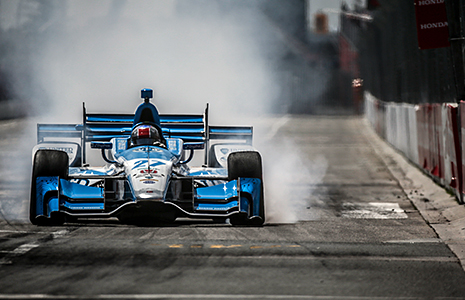TORONTO – One of the biggest complaints you'll hear from most drivers in the Verizon IndyCar Series is the lack of seat time.
Then again, sometimes, too much of something may not be a good thing.
With seven races in an eight-week span from the Indianapolis 500 through this weekend’s Honda Indy Toronto, the final race at the end of a busy two months of racing action puts huge pressures on drivers' physical fitness.
As they travel from race to race and battle for wins, the drivers have to let their exercise regimes slip a bit to accommodate the tight schedule, something that makes a tough sport even more demanding.
“It's very tough to stay fit,” said Simon Pagenaud, the reigning series champion driving No. 1 DXC Technology Team Penske Chevrolet on the streets of Toronto.
“It's just that it's so physical to drive these cars and you need to build strength in the gym to be fit enough to drive them. And when we don't have time to train as much, you kind of lose you fitness.”
 The physical demands on the drivers underlines the fitness level that's required to compete at the highest level in the Verizon IndyCar Series. The cars have massive downforce that creates huge G-forces in corners, no power steering that makes them a handful to turn and brake pedals that require upwards of 1,200 pounds per square inch of pressure to slow them in the corners (exemplified by the photo at left of Marco Andretti braking hard into Turn 1 at Toronto), not to mention the heat in the cockpit that can reach more than 100 degrees Fahrenheit.
The physical demands on the drivers underlines the fitness level that's required to compete at the highest level in the Verizon IndyCar Series. The cars have massive downforce that creates huge G-forces in corners, no power steering that makes them a handful to turn and brake pedals that require upwards of 1,200 pounds per square inch of pressure to slow them in the corners (exemplified by the photo at left of Marco Andretti braking hard into Turn 1 at Toronto), not to mention the heat in the cockpit that can reach more than 100 degrees Fahrenheit.
“People who think this sport is easy certainly don't really have a great concept of what it is all about,” said Graham Rahal, driver of the No 15 Rousseau Metal Honda for Rahal Letterman Lanigan Racing.
“It's tough sledding out there right now and we are going to continue to push extremely hard, but you have to be at your best each and every weekend. It's impressive right now what we go through (physically) and how good all of these guys are.”
If being at the end of a gruelling part of the season weren't enough, Toronto adds even more to the personal schedule of hometown boy James Hinchcliffe. The No. 5 Arrow Schmidt Peterson Motorsports Honda driver spends the week before the race running from event to event off the track as he makes time for his fans and promotes the race.
Hinchcliffe must ensure he doesn't take on too much during the weekend so he can concentrate on the job at hand, something he finds difficult because he wants to be available to make his home race a success.
“You don't want to say no to anybody and you want to be that guy, but you have to focus on the job, which is driving an Indy car,” said Hinchcliffe, whose third-place finish a year ago was his best in seven Toronto starts.
“The good news about having many races in a row is that there's no better training than physically being in the race car, so if that's what you are doing, it's fine. But a lot of what we do isn't driving. A lot of what we do comes down to things like sponsor appearances and media events and the like and that takes you away from home almost as much as driving the car does, and managing that is difficult.”
With the schedule incorporating stretches where there isn’t time to get to the gym, Pagenaud has devised a strategy to help stay in top form when he can't work out. The Penske driver ups his exercise regime in the offseason as the season opener approaches. He says it’s a way to bank a bit of fitness he can keep as a reserve when thing get tougher.
“You have to be very fit at the start of the season in March and try to carry it through and not lose too much weight,” Pagenaud said. “It's demanding on the body and demanding mentally as well because of
all the requests from partners and media and all the travel we do, but that's what makes you a champion.”